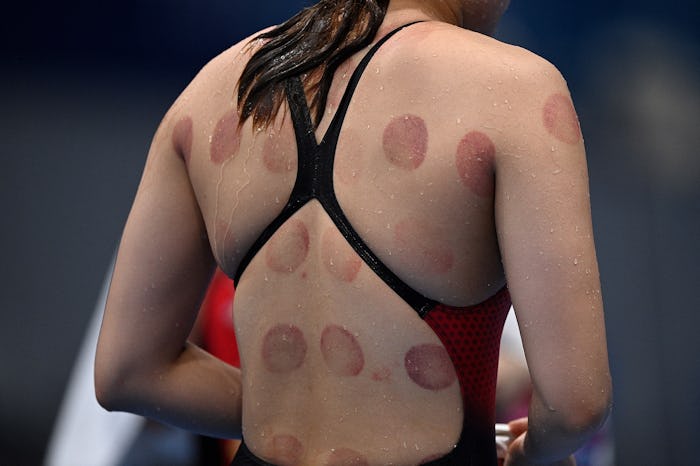Breastfeeding

This Common Treatment For Olympians *Might* Be Great For Breastfeeding Moms, Too
But honestly, anything sounds better than engorgement.
When Olympic athletes like swimmer Michael Phelps, and celebrities like Gwyneth Paltrow, turned to cupping — a form of traditional Chinese medicine — while simultaneously, and proudly, claiming it helps with pain and healing, the therapy grew exponentially in its popularity. As the 2022 Winter Olympics approach, more athletes on the world stage may bear tell-tale round, reddish brown marks as they compete. Surprisingly, another set of humans you might see sporting the temporary marks the practice leaves behind are breastfeeding moms. Yes, some practitioners believe that cupping might help moms with breastfeeding problems, like low supply, milk ejection issues, and even mastitis. (And as a mom with undersupply, I can tell you that I was willing to try pretty much anything to increase my supply.) But if you are thinking about trying cupping to help with breastfeeding, there are a few things to consider.
What Is Cupping?
The practice of cupping is a technique from traditional Chinese medicine in which heated glass cups are applied to the body. When the hot cup is placed onto the skin, it creates a vacuum that pulls the skin partially into the cup. As the cups cool, they create a vacuum drawing your skin and muscles into the cup and leaving a bruise and creating the sometimes-hard-to-look-at marks seen on Olympic athletes.
This particular method of medicine is theorized to help with pain and other medical problems by impacting the energy in your body or qi, according to Edzard Ernst, Emeritus Professor of Complementary Medicine at the University of Exeter and cupping practitioner. In an interview with The Conversation, Ernst explained that “Cupping has long existed in many cultures including China, ostensibly to stimulate the flow of energy in the body.”
How Can Cupping Help With Breastfeeding?
Studies that examine the efficacy of cupping to increase milk supply or relieve breastfeeding pain are scarce. Though there's just not a lot of solid research to show that cupping actually works to increase milk supply, anecdotally speaking, cupping is something that doula and birth educator Sara Lyon tells Romper can help alleviate some breastfeeding problems like engorgement.
“There are two primary ways to cup the breast tissue during lactation: to break up engorgement and draw milk down towards the nipple, and to draw milk out through the nipple,” Lyon explains. “The two practices may be used alone or in succession, first applying cups around the breast, then on the nipple. In cases of extreme engorgement or mastitis, these practices can also be performed with the lactation woman on all fours so that gravity assists in the flow of milk.”
Is Cupping Safe For Breastfeeding Moms?
It's important to consider the potential safety aspects of the treatment itself if you want to try cupping for breastfeeding. Lyon tells Romper that “cupping is safe for breastfeeding moms as long as the practitioner performing the treatment, or teaching mom to do it alone, is experienced and gentle.”
Since the practice of cupping has become more mainstream, there are even a few suction-style cups out there made specifically for use while breastfeeding. Lyon tells Romper, “In fact, there are some popular products on the market that create suction, like a cup, and collect any milk that flows.”
As painful as the marks from cupping look, the next question you might ask yourself about the process while breastfeeding is whether or not it’s painful. Unfortunately, cupping can hurt, but when done by an experienced practitioner, it shouldn’t be harmful.
“The breast tissue is sensitive on the best of days, so engorged postpartum breasts are extra sensitive and require a great deal of care when breaking up lactation congestion,” Lyon says. “Will cupping damage the breast tissue? With proper execution, it won't, but it could be very painful because the tissue is already inflamed.
According to the International Cupping Therapy Association, breastfeeding moms who want to start cupping actually need to "pump and dump" for a few days after each treatment session, because of potential toxins the treatment can release into your breast milk.
Just like other trending medical treatments endorsed by professional athletes, the efficacy and safety of partaking in cupping while breastfeeding is definitely something you want to talk with your doctor about. As Lyon noted, it’s especially important to find an experienced practitioner so you can make sure the practice is done with yours and your baby’s safety in mind.
Expert:
Sara Lyon, doula, owner/director Glow Birth & Body, author The Birth Deck and You’ve Got This
This article was originally published on